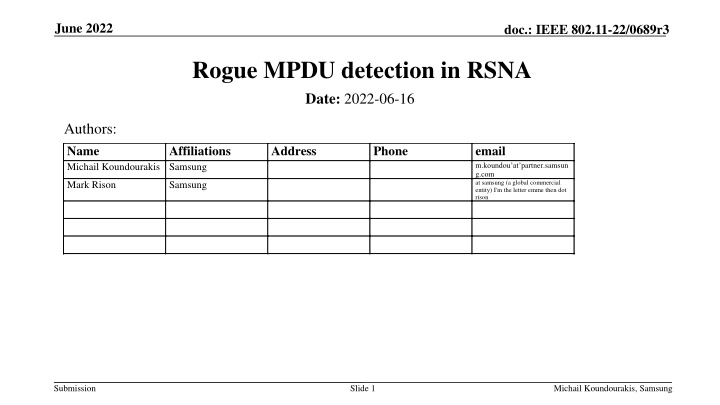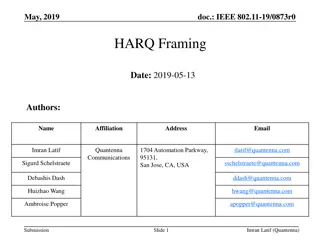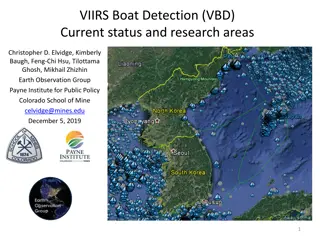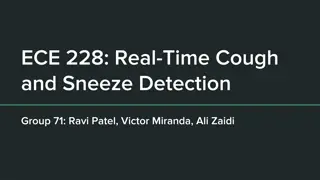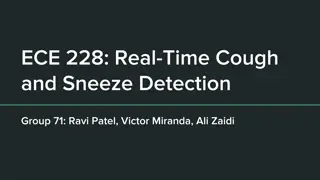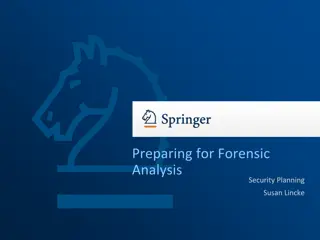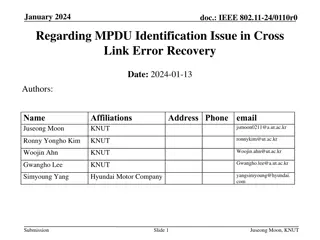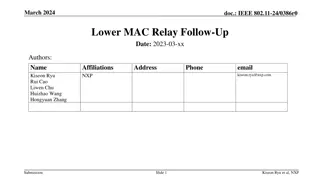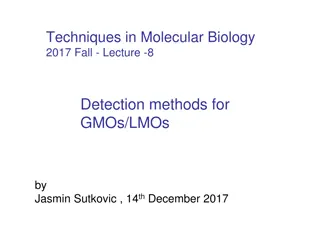Rogue MPDU Detection in RSNA Issues and Solutions
Abstract CIDs highlighted issues related to valid MPDUs not being acknowledged due to malicious attacks in RSNA. Efforts were made to enhance security using Protected Block Ack, but vulnerabilities persist. Various solutions are being explored, and input from group members is sought to find the best way forward. The example of an attack scenario illustrated how replay attacks can compromise the acknowledgment of valid MPDUs.
Download Presentation

Please find below an Image/Link to download the presentation.
The content on the website is provided AS IS for your information and personal use only. It may not be sold, licensed, or shared on other websites without obtaining consent from the author.If you encounter any issues during the download, it is possible that the publisher has removed the file from their server.
You are allowed to download the files provided on this website for personal or commercial use, subject to the condition that they are used lawfully. All files are the property of their respective owners.
The content on the website is provided AS IS for your information and personal use only. It may not be sold, licensed, or shared on other websites without obtaining consent from the author.
E N D
Presentation Transcript
June 2022 doc.: IEEE 802.11-22/0689r3 Rogue MPDU detection in RSNA Date: 2022-06-16 Authors: Name Michail Koundourakis Samsung Affiliations Address Phone email m.koundou at partner.samsun g.com at samsung (a global commercial entity) I'm the letter emme then dot rison Mark Rison Samsung Submission Slide 1 Michail Koundourakis, Samsung
June 2022 doc.: IEEE 802.11-22/0689r3 Abstract CIDs 1002, 1821, 1017, 1014, 1745, 1808, 1013, 1015 and 1016 raise issues related to valid MPDUs not getting acknowledged, as a result of malicious attacks. Efforts are made to improve the security and resolve some of these issues using Protected Block Ack, but there are still vulnerabilities which need further work. Offline discussion between some members established that there is a common understanding about the issues and a number of different solutions have been considered. We invite members to participate in the discussion, so that the group can identify the best way forward. Submission Slide 2 Michail Koundourakis, Samsung
June 2022 doc.: IEEE 802.11-22/0689r3 Summary of issues The 802.11 spec has rules to describe: Which MPDUs get Acked, using (unencrypted) SN in Block Ack Scoreboarding Control WinStartR divides SN space in new and old How MPDUs are discarded as Duplicates (based on SN), before the MPDU reaches the Reordering Buffer or it is checked for Replay (PN) Which MPDUs are accepted for buffering and reordering using SN, before the MPDU is check for Replay (PN) WinStartB divides SN space in new and old The existing rules allow Replays (detected late) to cause valid MPDUs to: I1: Not get Acked (WinStartR moved incorrectly) I2: Be discarded in the reordering buffer (rogue MPDU with same SN takes entry) Submission Slide 3 Michail Koundourakis, Samsung
June 2022 doc.: IEEE 802.11-22/0689r3 Example of an attack WinStartR = 1000 (recipient has received and Acked SNs up to 999) - Rogue device replays SN=999 MPDU, changing its SN to 2200 (> WinStartR+WinSizeR) - STA receives MPDU SN=2200 and it is a valid frame, so sets WinStartR=2200 - Peer transmits MPDU with SN=1000, but STA does not Ack SN=1000 in the BlockAck response due to: - 2200+2^11 = 152 <= 1000< 2200 - Reordering buffer processing drops the MPDU for the same reason (replay set WinStartB=2200) - Submission Slide 4 Michail Koundourakis, Samsung
June 2022 doc.: IEEE 802.11-22/0689r3 How to fix Issues Principles to ensure vulnerabilities are addressed: P1. Attacker cannot move WinStartR, or if WinStartR moved by an attacker does not cause legal MPDUs to not be Acked. How can an attacker move WinStartR: Unprotected Block Ack Request Replay (same PN using different SN) P2. Duplicate Detection can trust the MPDU SN unprotected, so in current specification only PN can be trusted. Receiver cache identifier RC9 in current Draft effectively disables Duplicate Detection for QoS Data under BA. P3. Block Ack Buffering and Reordering can trust the MPDU SN unprotected, so in current specification only PN can be trusted Submission Slide 5 Michail Koundourakis, Samsung
June 2022 doc.: IEEE 802.11-22/0689r3 Proposals (so far) P1 STA to support partial-state operation Scoreboard temporary record can be either forgotten or can relax partial-state rules to remove 2^11 SN space restrictions (discussion ongoing) P2 (link to support Protected Block Ack) Protect SN in AAD (Requires a new feature and support by both transmitter and recipient STA), or Use SN only after PN is checked (Requires changes to specification but no changes at the peer STA) P3 (link to support Protected Block Ack) STA to discard unsolicited Block Ack frames, and Protect SN in AAD, or Use PN to identify valid MPDUs in Reordering Buffer processing Full solution requires buffering multiple MPDUs in each position of the reordering buffer, but If STA can implement it, does not require peer STA support Submission Slide 6 Michail Koundourakis, Samsung
June 2022 doc.: IEEE 802.11-22/0689r3 Impact on Architecture Replay Detection Replay Detection Replay Detection Block Ack Buffering and Reordering And Duplicate Detection And Replay Detection Block Ack Buffering and Reordering Block Ack Buffering and Reordering Block Ack Buffering and Reordering Duplicate Detection Decryption Decryption Duplicate Detection Duplicate Detection Decryption Decryption Block Ack Scoreboarding Block Ack Scoreboarding Block Ack Scoreboarding Block Ack Scoreboarding PN considered in Duplicate and Buffering SN protected Baseline All valid MPDUs Acked Submission Slide 7 Michail Koundourakis, Samsung
June 2022 doc.: IEEE 802.11-22/0689r3 Specification Changes Not Acked MPDUs Specification changes to allow valid FCS MPDUs to be Acked. Discussion: Can restrict changes to apply when STA supports Protected BA Options: 1. Discard the temporary current record of scoreboard context control after a Block Ack is transmitted 2. Replace 2^11 with 2^12 in scoreboard context control operation Discussion: a) Option 1 is simple to implement and discarding of current record is allowed in some cases already b) Option 2 allows Ack information to be retained so may reduce retransmissions in some case when not all Block Ack frames are received by peer. TGm would have to select an option. Submission Slide 8 Michail Koundourakis, Samsung
June 2022 doc.: IEEE 802.11-22/0689r3 Specification Changes Discarded MPDUs Specification changes to fix issues with valid MPDU discarded. Prerequisite: Link supports Protected Block Ack Options: 1. Protect the SN. Can be added to AAD. 2. Use PN in Duplicate, Buffering and Reordering Discussion: a) Option 1 is simpler and robust, however requires a new feature to be defined and does not benefit implementations which cannot comply, e.g. AAD calculations implemented in Hardware, or when peer does not support. b) Option 2 does not need peer to change and does not require new calculations, so it likely implementable by existing devices. TGm would have to select one or even both options. Submission Slide 9 Michail Koundourakis, Samsung
June 2022 doc.: IEEE 802.11-22/0689r3 Option 2 Discussion Duplicate Detection and Replay Check if run in cooperation (i.e. until an MPDU reaches the start of the reordering buffer, duplicates are not identified and discarded) can be used to determine if an MPDU is legal, i.e. satisfies both SN Duplicate and PN Replay checks As a consequence: A replay within a reordering buffer cannot cause valid MPDUs to be discarded (since only one is currently stored) Submission Slide 10 Michail Koundourakis, Samsung
June 2022 doc.: IEEE 802.11-22/0689r3 Option 2 How it works Claim: Current spec rules run Replay Check after Duplicate Detection. A Replay may occupy a position in the reordering buffer and cause a valid MPDU (with the same SN as the rogue MPDU) to be discarded as Duplicate: It is also responsible for identifying and discarding duplicate frames (i.e., frames that have the same sequence number as a currently buffered frame) that are part of this block ack agreement. Fix: When Duplicate Detection and Replay Check run in consecutive steps, Replay can be detected, rogue MPDU dropped and valid MPDU accepted Submission Slide 11 Michail Koundourakis, Samsung
June 2022 doc.: IEEE 802.11-22/0689r3 Conclusion Security can be improved using either a protected SN, or the protected PN Discussion so far raise confidence that issues can be addressed Option 2 is worth considering, if members believe: issues shall be addressed without defining a new feature (protected SN), and Proposed Option 2 (PN-only checks) is implementable by existing devices Otherwise, Option 1 would be the preferred way forward note that it would be a new feature that might not be possible via firmware upgrade Submission Slide 12 Michail Koundourakis, Samsung
